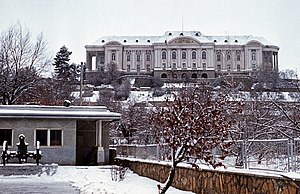
Back عملية العاصفة-333 Arabic Щурм срещу двореца на Хафизула Амин Bulgarian Operació Tempesta-333 Catalan Operace Bouře 333 Czech Operation Storm-333 German Επιχείρηση Καταιγίδα-333 Greek Operación Tormenta-333 Spanish Operatsioon Štorm-333 Estonian عملیات طوفان-۳۳۳ Persian Operaatio Štorm 333 Finnish
| Tajbeg Palace assault | |||||||
|---|---|---|---|---|---|---|---|
| Part of the prelude to the Soviet–Afghan War | |||||||
 The Tajbeg Palace, where the Soviet assault took place, photographed in 1987 | |||||||
| |||||||
| Belligerents | |||||||
|
|
| ||||||
| Commanders and leaders | |||||||
| Hafizullah Amin X | |||||||
| Units involved | |||||||
| Army guard detachment | |||||||
| Strength | |||||||
| 660 | 2,200[1] | ||||||
| Casualties and losses | |||||||
| 40 casualties[1] | 2,203 casualties[2] | ||||||
Operation Storm-333 (Russian: Шторм-333, Štorm-333) was a military raid executed by the Soviet Union in Afghanistan on 27 December 1979. Special forces and airborne troops stormed the heavily fortified Tajbeg Palace in Kabul and assassinated Afghan leader Hafizullah Amin, a Khalqist of the People's Democratic Party of Afghanistan (PDPA) who had taken power in the Saur Revolution of April 1978. It was the start of the Soviet–Afghan War.
The assassination of Amin was part of a larger Soviet plan to secure and take control of Afghanistan with support from the PDPA's Parcham faction, which opposed the hardline ideology espoused by the rival Khalq faction; a number of Soviet troops crossed the Amu Darya and entered Afghanistan by land while others flew to airbases around the country with exiled Parchamis in preparation for the assassination.[3] The Tajbeg Palace, located on a high and steep hill in Kabul,[4] was surrounded by landmines and guarded by extraordinarily large contingents of the Afghan National Army.[5] Nonetheless, Afghan forces suffered major losses during the Soviet operation;[2] 30 Afghan palace guards and over 300 army guards were killed while another 150 were captured.[6] Two of Amin's sons, an 11-year-old and a 9-year-old, died from shrapnel wounds sustained during the clashes.[7] In the aftermath of the operation, a total of 1,700 Afghan soldiers who surrendered to Soviet forces were taken prisoner,[3] and the Soviets installed Babrak Karmal, the leader of the PDPA's Parcham faction, as Amin's successor.
Several other government buildings were seized from Amin's Khalqist government during the operation, including those for the Ministry of Interior Affairs, KAM, and the General Staff (Darul Aman Palace). Veterans of the Soviet Union's Alpha Group have stated that Operation Storm-333 was one of the most successful in the unit's history. Documents released following the dissolution of the Soviet Union in the 1990s revealed that the Soviet leadership believed Amin had secret contacts within the American embassy in Kabul and "was capable of reaching an agreement with the United States";[8] however, allegations of Amin colluding with the Americans have been widely discredited, with the Soviet archives revealing that the story of Amin as a CIA agent had been planted by the KGB.[9][10][11]
- ^ a b Peter Tomsen (9 June 2011). Wars of Afghanistan (1st ed.). PublicAffairs. p. 174. ISBN 978-1586487638.
- ^ a b Lester W. Grau. "The Take-Down of Kabul: An Effective Coup de Main". Global Security. Retrieved 7 December 2018.
- ^ a b "Afghanistan: Lessons from the Last War". nsarchive2.gwu.edu. Retrieved 23 March 2023.
- ^ Cite error: The named reference
Lyakhovskiy1995was invoked but never defined (see the help page). - ^ Michael Newton (17 April 2014). Famous Assassinations in World History: An Encyclopedia. ABC-CLIO. p. 17. ISBN 9781610692861.
- ^ Martin McCauley (2008). Russia, America and the Cold War: 1949–1991 (Revised 2nd ed.). Harlow, UK: Pearson Education. ISBN 9781405874304.
- ^ "How Soviet troops stormed Kabul palace". BBC. 27 December 2009. Retrieved 1 July 2013.
- ^ John K. Cooley (2002) Unholy Wars. Pluto Press. p. 8. ISBN 978-0745319179
- ^ Coll, Steve (2004). Ghost Wars: The Secret History of the CIA, Afghanistan, and Bin Laden, from the Soviet Invasion to 10 September 2001. Penguin Group. pp. 47–49. ISBN 9781594200076.
Frustrated and hoping to discredit him, the KGB initially planted false stories that Amin was a CIA agent. In the autumn these rumors rebounded on the KGB in a strange case of "blowback," the term used by spies to describe planted propaganda that filters back to confuse the country that first set the story loose.
- ^ James G. Blight (2012). Becoming Enemies: U.S.-Iran Relations and the Iran-Iraq War, 1979-1988. Rowman & Littlefield Publishers. p. 70. ISBN 978-1-4422-0830-8.
- ^ Seth G. Jones (2010). In the Graveyard of Empires: America's War in Afghanistan. W. W. Norton & Company. pp. 16–17. ISBN 9780393071429.
'It was total nonsense,' said the CIA's Graham Fuller. 'I would have been thrilled to have those kinds of contacts with Amin, but they didn't exist.'